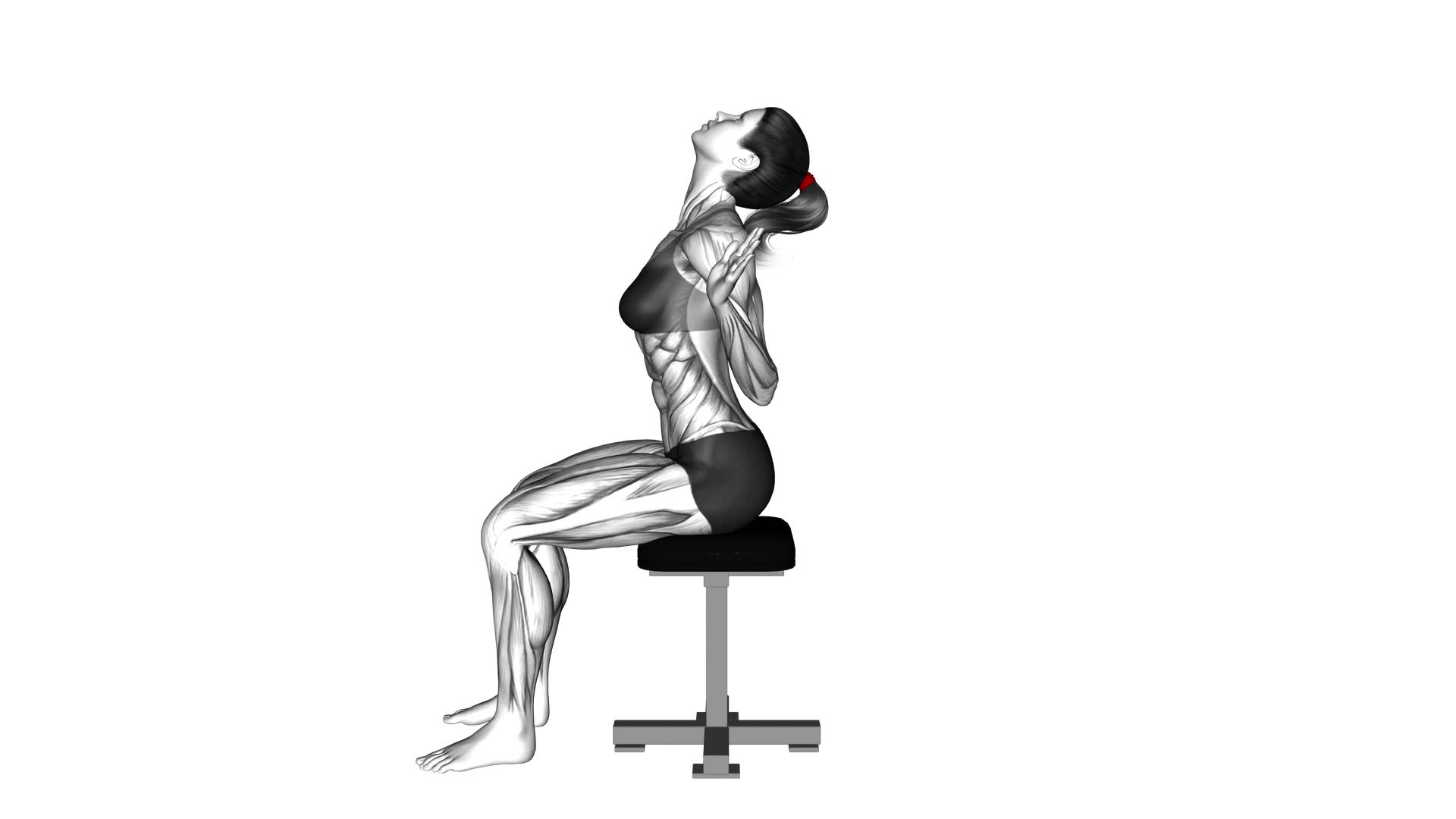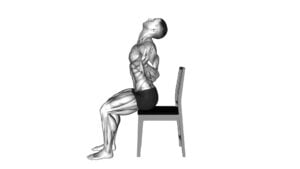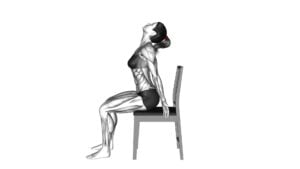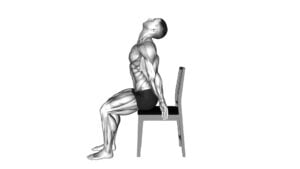Sitting Scapular Adduction (VERSION 2) (female) – Video Exercise Guide & Tips

Looking to improve your posture and strengthen your upper back?
Watch This Exercise Video
In this video exercise guide, we'll walk you through Sitting Scapular Adduction (Version 2).
With just a few simple adjustments, you'll be able to target and engage the muscles responsible for proper shoulder blade movement.
Whether you're a beginner or an advanced practitioner, we've got modifications and tips to help you get the most out of this exercise.
So grab a chair and get ready to transform your upper body strength!
Key Takeaways
- Sitting scapular adduction improves posture, strengthens upper back and shoulders, corrects rounded shoulders, and promotes better alignment.
- Using equipment such as dumbbells or resistance bands provides stability, targets muscles effectively, allows for gradual increase in difficulty, promotes muscle growth and strength, and reduces the risk of injury.
- Alternatives to expensive equipment include resistance bands, water bottles or cans as makeshift weights, towels or yoga blocks for support and modification, stairs or step stools for step-ups or elevated platform, and DIY exercise equipment solutions for home workouts.
- Proper form and technique are important to maintain throughout the exercise to increase effectiveness, reduce strain on the neck and upper traps, improve posture and alignment, make necessary modifications, and minimize the risk of injury.
Benefits of Sitting Scapular Adduction
Experience the numerous benefits of sitting scapular adduction for improved posture and upper body strength. Sitting scapular adduction is a simple yet effective exercise that targets the muscles in your upper back and shoulders, helping to correct rounded shoulders and promote better alignment. By pulling your shoulder blades together and down, you activate the muscles that are responsible for retracting and depressing the scapulae. This exercise not only improves your posture but also enhances your upper body strength.
One of the key benefits of sitting scapular adduction is that it can be done anywhere, making it a convenient exercise for those with busy schedules or limited access to a gym. Additionally, it requires no equipment, making it a cost-effective alternative to other exercises that target the same muscle group. For those seeking a greater challenge, there are progressions for advanced practitioners, such as adding resistance bands or weights to increase the intensity of the exercise.
Incorporating sitting scapular adduction into your regular exercise routine can lead to significant improvements in your posture and upper body strength. Not only will you look taller and more confident, but you'll also experience reduced pain and discomfort in your neck, shoulders, and upper back.
Equipment Needed for the Exercise
To effectively perform the Sitting Scapular Adduction exercise, you'll need some equipment. The required equipment for this exercise includes:
- A bench or chair
- Dumbbells or resistance bands
- A mat or towel for comfort
Using equipment such as dumbbells or resistance bands adds resistance to the exercise, which helps strengthen and tone the muscles involved. If you don't have access to these items, there are alternative options and modifications that can still provide a challenging workout.
Required Equipment for Exercise
You'll need a chair and a resistance band for this exercise. These two pieces of equipment are essential for maximizing the benefits of the sitting scapular adduction exercise. Using a chair provides stability and support, ensuring proper form and minimizing the risk of injury.
The resistance band adds resistance to the movement, targeting the muscles in your scapula and upper back more effectively. While there are cost-effective alternatives to these equipment, such as using a sturdy surface instead of a chair or substituting a towel or belt for a resistance band, it's recommended to invest in the proper equipment for optimal results.
Now, let's explore the benefits of using equipment in this exercise and how it can enhance your workout.
Benefits of Using Equipment
Using the proper equipment for the sitting scapular adduction exercise enhances the effectiveness of the workout by providing stability, support, and targeted resistance.
While this exercise can be performed without any equipment, using certain equipment can help optimize your results.
One popular equipment option is resistance bands, which provide variable resistance and allow you to gradually increase the difficulty of the exercise as you progress.
Another alternative is using dumbbells or kettlebells to add external resistance to the movement. These options help engage your muscles more effectively and promote muscle growth and strength.
Additionally, using equipment such as a stability ball or an exercise bench can provide added support and stability during the exercise, reducing the risk of injury and allowing for proper form.
To maximize the effectiveness of this exercise, choose the equipment that best suits your fitness level and goals, and always ensure proper technique and form.
Alternatives to Expensive Equipment
If you don't have access to expensive equipment, there are still alternatives available for the equipment needed for the exercise. Here are some affordable alternatives for home workouts and DIY exercise equipment solutions:
- Resistance bands: These versatile bands provide resistance and can be used in place of weights for strength training exercises.
- Water bottles or cans: These can be used as makeshift weights for exercises like bicep curls or shoulder presses.
- Towels or yoga blocks: These can be used to support and modify certain exercises, such as providing extra stability during planks or assisting with stretching.
- Stairs or step stools: These can be used for step-ups or as an elevated platform for exercises like tricep dips.
Proper Form and Technique
To perform the Sitting Scapular Adduction exercise with proper form and technique, it's crucial to focus on maintaining proper alignment throughout the movement. This means keeping your spine straight, shoulders relaxed, and core engaged.
Common mistakes to avoid include rounding your shoulders, hunching forward, or using momentum to complete the exercise. By ensuring proper technique, you can maximize the benefits of this exercise, which include strengthening the muscles of the upper back, improving posture, and preventing injuries.
Importance of Alignment
You should always prioritize proper alignment when performing the Sitting Scapular Adduction exercise. Proper alignment is crucial for maximizing the benefits of the exercise and minimizing the risk of injury.
Here's why alignment is so important:
- Correct alignment ensures that the targeted muscles are properly engaged, leading to optimal muscle activation and strengthening.
- Proper form and technique help maintain joint stability and integrity, reducing the risk of strain or injury.
- Aligning your body correctly helps maintain a neutral spine, promoting good posture and reducing the risk of back pain.
- By focusing on alignment, you can improve body awareness and develop better overall body mechanics, which can enhance your performance in other exercises and daily activities.
Common Mistakes to Avoid
Maintain proper form and technique when performing the Sitting Scapular Adduction exercise to avoid common mistakes and ensure optimal results.
One common mistake to avoid is shrugging your shoulders during the movement. This can decrease the effectiveness of the exercise and put unnecessary strain on your neck and upper traps. Instead, focus on keeping your shoulders relaxed and down throughout the exercise.
Another mistake to watch out for is using momentum to complete the movement. This can happen if you're using too much weight or not controlling the movement properly. To avoid this, make sure to use a weight that allows you to perform the exercise with controlled and smooth movements.
Lastly, be mindful of your posture and alignment during the exercise. Avoid rounding your shoulders or slouching forward, as this can lead to improper form and decreased effectiveness.
Benefits of Proper Technique
Proper form and technique in the Sitting Scapular Adduction exercise yield numerous benefits, including increased effectiveness, reduced strain on the neck and upper traps, and improved posture and alignment. By maintaining proper alignment throughout the exercise, you can maximize the benefits and minimize the risk of injury.
Here are some key reasons why proper technique is important:
- Increased effectiveness: When you perform the exercise with proper form, you engage the targeted muscles more efficiently, leading to better results.
- Reduced strain on the neck and upper traps: Proper technique ensures that the load is properly distributed, reducing the strain on these areas and preventing discomfort or injury.
- Improved posture and alignment: The Sitting Scapular Adduction exercise helps strengthen the muscles responsible for maintaining good posture, leading to improved alignment and reduced risk of postural issues.
- Exercise modifications: Proper technique allows you to make necessary modifications to the exercise, such as adjusting the range of motion or resistance, to suit your individual needs and abilities.
Modifications for Beginners and Advanced Practitioners
To modify the sitting scapular adduction exercise for beginners and advanced practitioners, start by adjusting the resistance level to suit your current fitness level. This exercise can be modified to prevent injuries and accommodate different fitness levels.
For beginners, it's important to start with a lighter resistance band or weight. This will allow you to focus on the correct technique and gradually build strength. As you progress, you can increase the resistance to continue challenging your muscles.
For advanced practitioners, you can make the exercise more challenging by using a heavier resistance band or weight. This will help to further develop your scapular muscles and improve overall strength. Additionally, you can incorporate variations into the exercise to target different muscle groups. For example, you can perform the exercise with one arm at a time or use a unilateral resistance band. These variations will engage more stabilizer muscles and provide a greater challenge.
Remember to always maintain proper form throughout the exercise, regardless of your fitness level. This includes keeping your back straight, shoulders relaxed, and core engaged. If you experience any pain or discomfort, make sure to adjust the resistance or consult with a fitness professional for guidance.
Common Mistakes to Avoid
To avoid common mistakes during the sitting scapular adduction exercise, pay attention to your form and be mindful of the following guidelines:
- Maintain proper posture: Sit up straight with your feet flat on the floor and your shoulders relaxed. Avoid slouching or hunching forward, as this can compromise the effectiveness of the exercise and increase the risk of injury.
- Engage your core: Before starting the exercise, activate your core muscles by drawing your belly button towards your spine. This will help stabilize your spine and improve overall body alignment.
- Avoid excessive shoulder shrugging: As you perform the scapular adduction, be careful not to shrug your shoulders towards your ears. This common mistake can put unnecessary strain on your neck and upper traps, leading to discomfort and potential injury.
- Control the movement: Focus on controlling the movement of your shoulder blades throughout the exercise. Avoid using momentum or jerking motions, as this can reduce the effectiveness of the exercise and increase the risk of strain or injury.
Tips for Maximizing the Effectiveness of the Exercise
To maximize the effectiveness of the exercise, focus on maintaining proper form and engaging your core throughout. By doing so, you can ensure that you're targeting the intended muscles and maximizing your results.
Firstly, pay attention to your posture. Sit up straight with your shoulders back and down, and avoid slouching or hunching forward. This will help to activate your scapular muscles and promote proper movement during the exercise.
Additionally, it's important to keep your core engaged throughout the movement. This means contracting your abdominal muscles and maintaining a stable and strong core. By doing so, you won't only enhance the effectiveness of the exercise but also protect your lower back from unnecessary strain.
Finally, focus on the quality of your movements. Rather than rushing through the exercise, take your time and concentrate on performing each repetition with control and precision. This will allow you to fully engage the targeted muscles and make technique improvements over time.
Frequently Asked Questions
Can Sitting Scapular Adduction Help Improve Posture?
Sitting scapular adduction can indeed help improve your posture. By engaging in this exercise, you can correct rounded shoulders and enhance shoulder stability.
This movement focuses on retracting your shoulder blades, which helps counteract the effects of poor posture. By regularly practicing sitting scapular adduction, you can strengthen the muscles responsible for maintaining proper alignment, leading to improved posture and reduced risk of shoulder injuries.
Make sure to incorporate this exercise into your routine for maximum benefits.
How Often Should I Perform Sitting Scapular Adduction Exercises?
To improve your posture, it's recommended that you perform sitting scapular adduction exercises regularly. These exercises can benefit desk workers by strengthening the muscles in your upper back and shoulders, helping to correct rounded shoulders and improve overall posture.
To incorporate these exercises into your daily routine, you can set aside a few minutes each day to perform them. Consistency is key, so aim to do them at least 3-4 times a week for optimal results.
Can Sitting Scapular Adduction Help Prevent Shoulder Injuries?
Sitting scapular adduction exercises can definitely help prevent shoulder injuries.
By engaging in this exercise regularly, you can strengthen the muscles around your shoulder blades, improving their stability and reducing the risk of injury.
Scapular adduction also promotes proper shoulder alignment, which is crucial for preventing strain and overuse injuries.
Additionally, this exercise can enhance your overall posture and shoulder mobility, providing numerous benefits for your upper body strength and functionality.
Is It Normal to Feel a Slight Discomfort During the Exercise?
Feeling a slight discomfort during the sitting scapular adduction exercise is normal. However, it's important to ensure that you're using proper form and technique to avoid any unnecessary strain or discomfort.
Some common mistakes to avoid include hunching your shoulders, rounding your back, or using too much weight. Remember to keep your back straight, engage your core muscles, and focus on squeezing your shoulder blades together.
Can Sitting Scapular Adduction Help Improve Upper Body Strength?
Sitting scapular adduction can definitely help improve your upper body strength. By focusing on this exercise, you're targeting the muscles responsible for stabilizing your shoulders. This helps to enhance your overall shoulder stability, which is crucial for performing various upper body movements and exercises.
Additionally, practicing scapular adduction regularly can have additional benefits such as improving posture and reducing the risk of shoulder injuries. So, incorporating this exercise into your routine can be highly beneficial for your upper body strength and overall fitness.
Conclusion
In conclusion, sitting scapular adduction is a beneficial exercise that targets the muscles in the shoulder blades, improving posture and overall upper body strength.
With the use of minimal equipment, this exercise can be easily incorporated into a workout routine.
By maintaining proper form and technique, beginners and advanced practitioners can maximize the effectiveness of the exercise.
Avoiding common mistakes and following the provided tips will ensure a safe and efficient workout.
Incorporate sitting scapular adduction into your fitness regimen for optimal results.

Author
Years ago, the spark of my life’s passion ignited in my mind the moment I stepped into the local gym for the first time. The inaugural bead of perspiration, the initial endeavor, the very first surge of endorphins, and a sense of pride that washed over me post-workout marked the beginning of my deep-seated interest in strength sports, fitness, and sports nutrition. This very curiosity blossomed rapidly into a profound fascination, propelling me to earn a Master’s degree in Physical Education from the Academy of Physical Education in Krakow, followed by a Sports Manager diploma from the Jagiellonian University. My journey of growth led me to gain more specialized qualifications, such as being a certified personal trainer with a focus on sports dietetics, a lifeguard, and an instructor for wellness and corrective gymnastics. Theoretical knowledge paired seamlessly with practical experience, reinforcing my belief that the transformation of individuals under my guidance was also a reflection of my personal growth. This belief holds true even today. Each day, I strive to push the boundaries and explore new realms. These realms gently elevate me to greater heights. The unique combination of passion for my field and the continuous quest for growth fuels my drive to break new ground.







